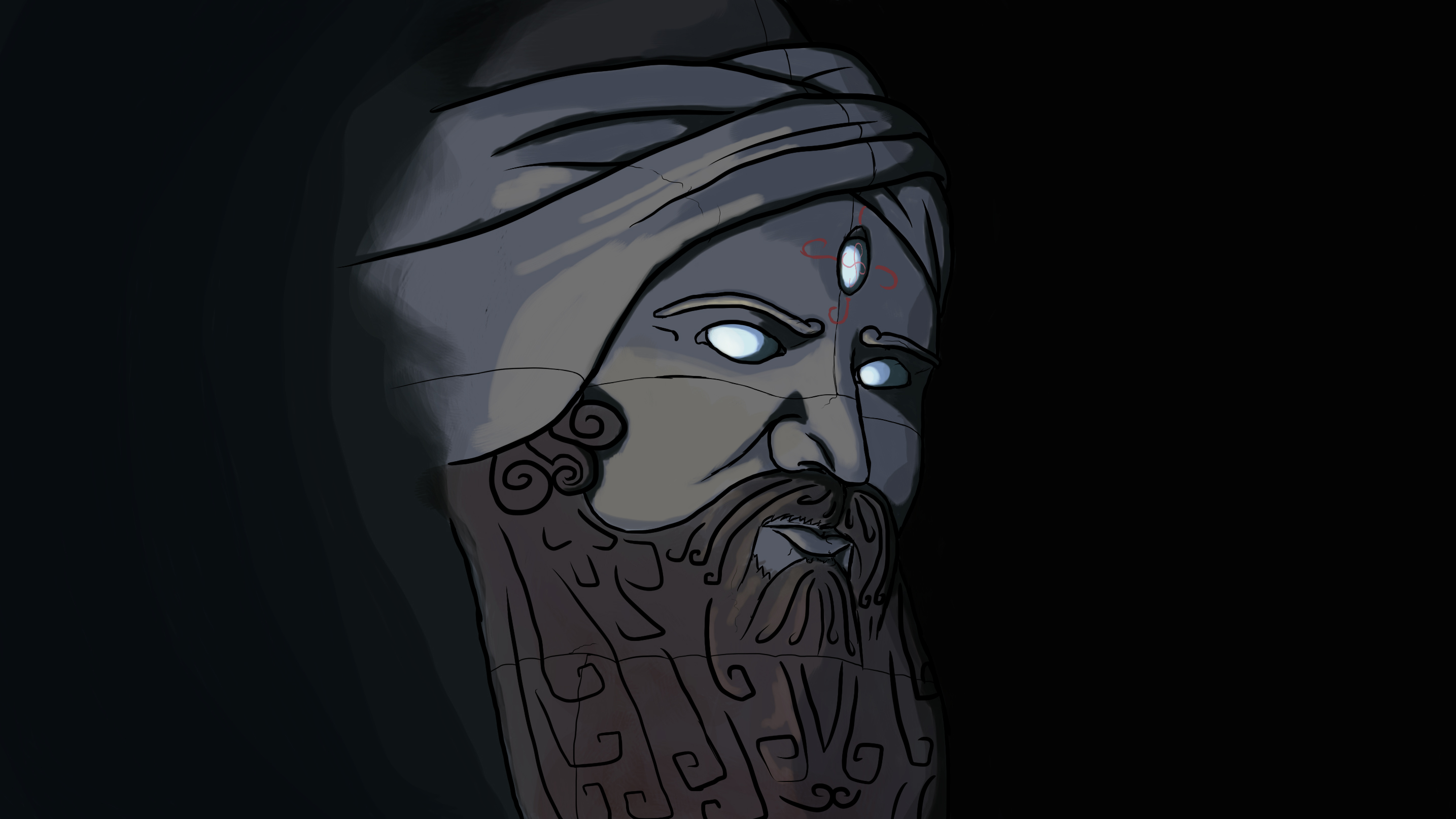
“They were our masters. They had wisdom. Their strength was mighty, their knowledge broad. Their craftsmanship unsurpassed. They willed the greatest of the last epoch. They built high, dug deep, spanned far. There was not a place our Old Masters went that could not be seen. But our Old Masters were cruel. They lacked kindness, lacking no cruelty. They held no charity, having much in way of greed. They demanded more, having all ego and pride. They were not civil, demanding us to be slaves and putting on our backs their world; they were slothful. They sent missions to our surface world, raping it of its beauty for their own demands, they were lustful.
“And when they saw what the Gods had, they demanded that. They reached to meet creation, only to be inflamed by its might. For once straddled with the weight of their karma. And with a plunge they drowned in fire and rock.”
Jainsura, On the Visha
Do The Eagles Circle The Mountain
Nearly four hundred years have passed since the collapse of the underground Empire of Vishashtan. But though they are gone their legacy remains. In the mythology of the kingdoms and rajas that have replaced them there is a common thread of involvement by the now legendary people of the underground. Whether as dreaded masters who held them in slavery or as a model of existence, existing as a romanticized effort of poets and bards as much as kings and queens.
And now scattered across the landscape atop the graves of the Old Empire new kingdoms vie for control and survival. The Visha's legacy having not failed to touch and effect every party in some distant way.
The Empire of the Visha
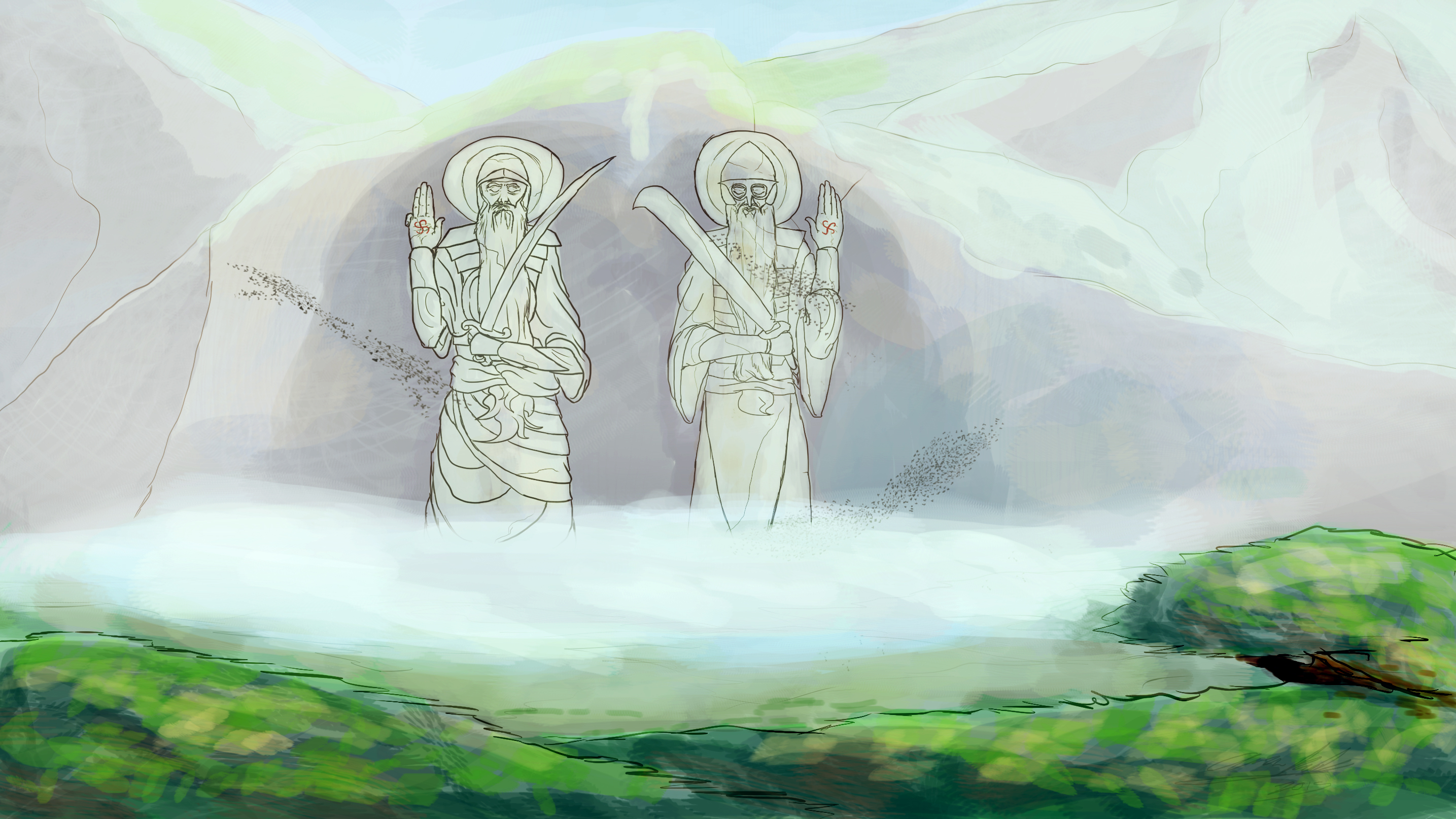
“They were as wonderful as they were terrifying, distantly alien in ways, but also human. They inspired a dread and reverence in their majesty. But they wouldn't ever notice any passes at honor.”
Anonymous
The origins of the dwarves are a fickle mystery to even the most trained scholar and what arises from the question is a forest of answers posing one's own theories and ideas. Some say they were just another race of man that moved underground to avoid a great primordial war. Others suggest they were a early creation of the gods, and all their wisdom but none of their divine judgment. In which ever the case they were an Empire of the mountains that came to dominate the lands they knew of as Gaṇājya.
To them, Gaṇājya encompassed the world from the southernmost islands to the vast northern desert and arctic steppe that straddled the northern face of their mountain home. This was a diverse land, which they ignored in whole by not living in it, but under it. Some time over a millennium ago they set out of the mountains and into the low lands of southern Gaṇājya. Though their armies smaller than the local inhabitants, they possessed even at that time a more forward understanding of metallurgy and weapon design. They were able to repress the largest of kingdoms in great speed, enslaving entire populations and ordering them to dig. With these slave armies they repressed entire states from nobility to peasant and expanded their own Empire.
Well within their first century of conquest they plundered and owned the southern lands from the mountains to the furthest southern jungles. All the while consolidating their hold and building their native cities over additional centuries worth of digging. Using means well lost and forgotten to even their few ancestors they dug great roadways under the rock and under the clay. Built massive cities in caverns gouged out from the very rock. Their civilization was monolithic and ever spreading. Further out and further down. And the might of their technological growth grew to almost mythology. Stories and evidence of iron wagons that ran on tracks still persist in the legends of the Visha's slaves' ancestors.
For the Visha themselves – often referred to as Vishput or Vishaput or many other names from many people – they've been often physically described as “beautiful”. Stout in nature, they seemed to tower over their own slaves. Possessing great silver beards they wore in their belts. And possessing a third eye of wisdom. As written:
“... the Visha with skin of gold. Possessing eyes with the clarity of diamonds. Emitting innumerable rays of light that struck terror. Masters of the underground, ears long and all hearing. They with a third eye. They with a scroll in one hand, and sword in the other. The Four Winds carved into their palm. Eternity embodied. Knowing all four points of reincarnation and masters of thus.”
Jainsura, On the Visha
Other notable feats of the Visha include the creation of golems, semi-living slaves made from rock and metal that patrol the halls of their faded Empire, carrying out basic orders. Though all those that remain are those designed to kill, and they will kill to defend masters long dead.
The decline of the Visha came to many out of the blue and there's no solid explanation. For the world their exit is as mysterious as their entry. For some they dug too deep, flooding their tunnels with magma and choking out their own people if they did not burn. Some say the gods grew offended and finally struck their Empire with a great cataclysm that destroyed them and struck down their greatest castes of builders and inventors.
Those Visha the remain are too far and too few to ever rebuild. They have long fled the underground and the new horrors that live in its shadows. To them, the means of their people's greatness are well and lost. None know any longer how to build as they did. Their life now is marked by shame or by persecution, forcing them to hide themselves and assume the identity of lowly men to prevent the angry or the superstitious from slaying them.
The Ruined Underground of the Visha and the Shishkarat
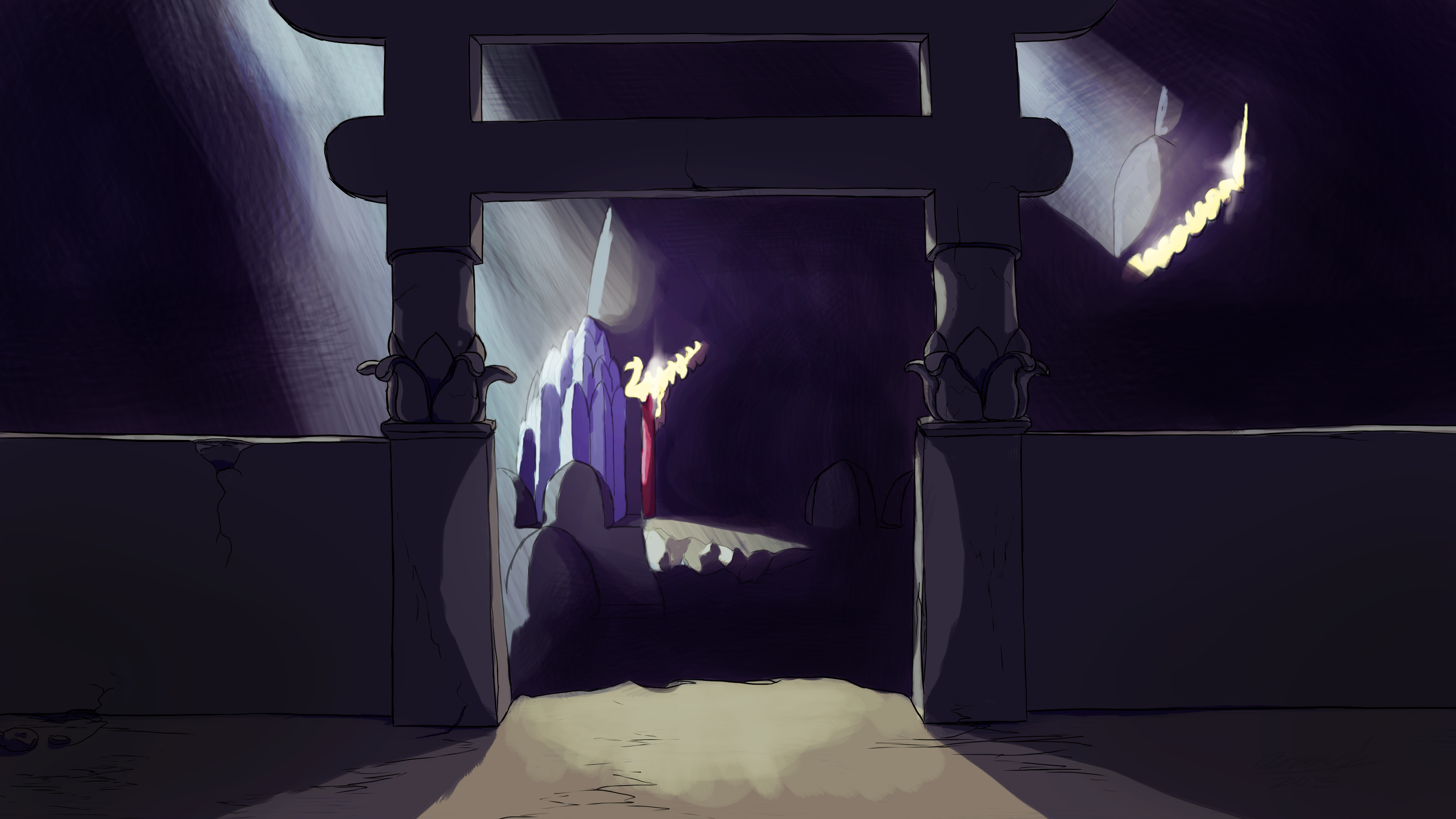
The Empire of the Visha held its greatest presence underground with a winding and complex series of underground roads connecting settlements the size of villages to the size of great metropolises. These great caverns were carved from the bare rock or built to utilize existing cavern and chasm networks that had eroded out in the stone itself. Over the span of their Empire the system expanded, tunnels widening to triumph over even the widest surface avenues with a size to match the peaks of any an all temples. Like wise the cities were as magnificent.
However since the disappearance of the Visha Empire and the underground's subsequent total abandonment the tunnels and old cities have become inhabited again. Occupied by a diminutive race of goblin-esque bat-creatures, the Empire of the Visha has become a haven for the many hordes and tribes of the Shishkarat, beings of minor intelligence and organization but all the same infinite in their numbers.
Some believe the existence of the Shishkarat coincided with that of the collapse of the Visha. For all the skill and might of the Vishput it was nothing that could compete with the stalwart determination and never-ending bulk of slathering and rabid beasts. Their appearance in the underground may not have happened the moment the Visha world came to a standstill, but it sure did come close.
Since the collapse of the Visha many of the deeper tunnels have become a haven for the Shishkarat with their primitive civilization priming in the deepest halls. Forays higher up have turned the more surface settlements and tunnels into glorified hunting grounds. The Shisha warrior and hunters may even come up higher, breaching the surface itself at night. Over the last century there has been a trickling increase of the roving goblins skulking the jungles and fields. On their own, isolated peasants and even small teams are weak against the rabid Shisha who attack with rudimentary tools and weapons, crafted from rock or re-purposed from Visha artifacts. But for all their danger the Shishkarat aren't a match to anything armed and appropriately trained, professional guards, warrior-trained nobility, and adventurers alike have found a service niche, industry, or cause in guarding their fief's countryside against being pillaged.
The present Shishkarat are not the only lively dangers below. In addition to natural hazards present in the caves for any explorers or expeditions sent down from the kingdoms above, or parties of their own wish there exists in the darkness a still working legacy of the Visha. Namely, their golems. Built as sentries to patrol against the very threats such as the Shisha or their own slaves the hulking automatons of the Vishput still wander the halls as an immortal shield against what they perceive as dangers in the shadows. Built of metal and stone they are as strong and rugged as an elephant, if more so.
The only fortune is they are uncommon in the underground. Though nearly unstoppable by the common arms and weapons explorers may enter with.
But despite the dangers there may be many incentives to still yet consider the underground world. Whether as a plane unclaimed to consolidate power for the rajas, maharajas, and sultans of above to consider. And if not for any perceived tactical benefits of trying, there is at least the wealth rumored to lie below. And if none yet still apply, there is all the same the monolithic backdrop it all provides.
The World

The world of Gaṇājya, three centuries after the collapse of the Empire of Vishashtan. The Samraat – Emperor - that ruled from the stone below are long gone from the physical world, though their legacy remains carved in the physical stone and in the background of the surface kingdom's lore and legacy. They may have traded, they may have fought with, they may have fought alongside, or they may have been slaves and subjects to the Visha.
And their underground remains, though unfit for civilization. But enough more than enough is there as to be dangerous or rewarding.
Some basic information about the map:
In general the region depicted covers a land area roughly equal to half the land area of Eurasia. A rough estimate would be about 20,000,000 kilometers square. So immense, and there's plenty of room for diversity, even with the Vishput's legacy enforcing a sort of Indian theme across the southern lands. And as shown I have included the 10 degree and 50 degree parallels. This world being the same in size to Earth that makes the distance north-south between the two 2,757.7 miles.
Now, those aren't the only details. I have the map broken into regions as well an underground map for important Visha cities and major underground highways that they built. But first, the immediately important thing...
Regions
Regions will not be named. That's up for the players to determine. As well as assigning some geographic of climate differences regions also help in dictating some cultural consistency in a given area.
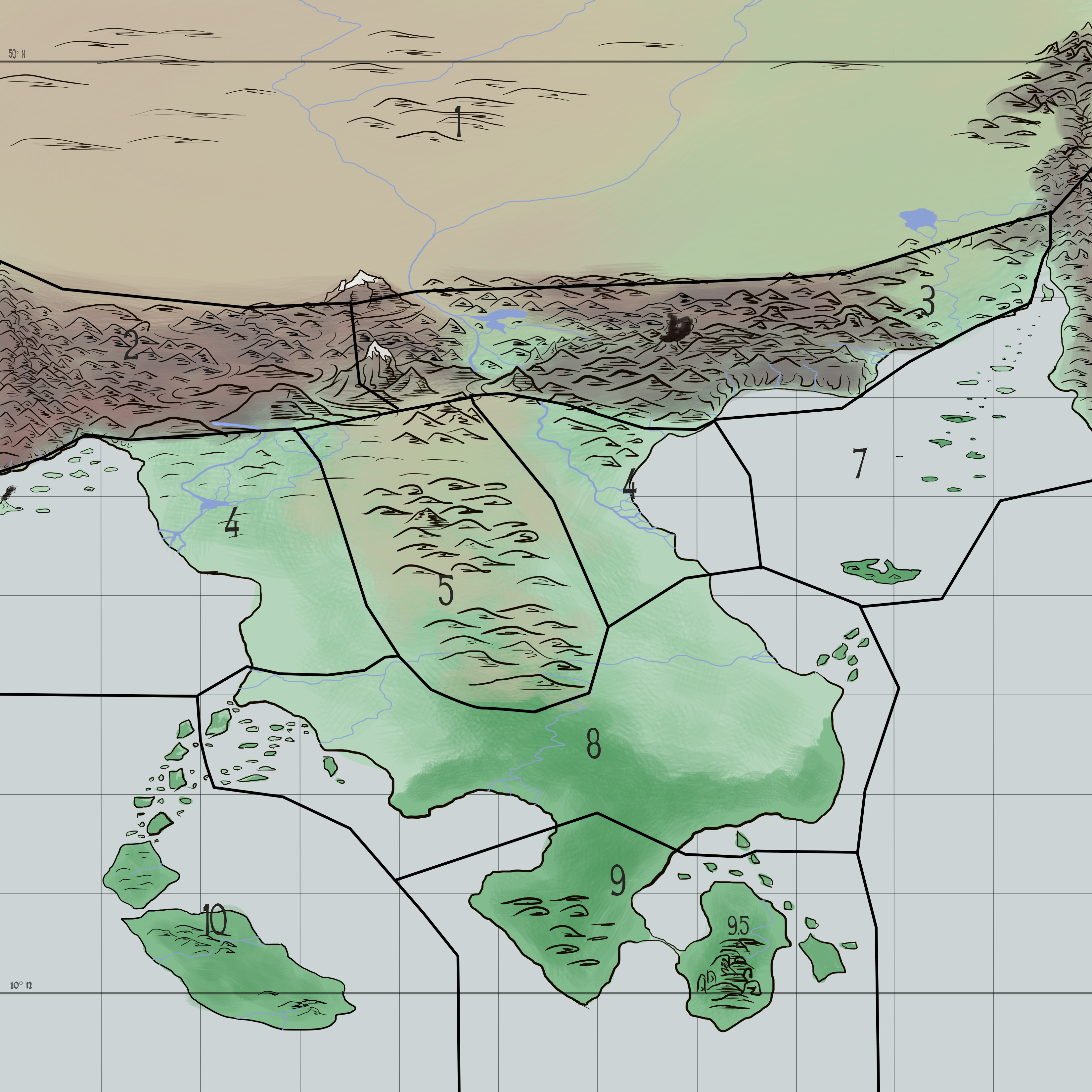
Region 1 – Faced with a massive mountain shield at the south the massive deserts beyond the mountains march far into the insurmountable distance. And defined by high altitude steppes in the south as the mountains there crawl and peter northwards and a vast arctic wasteland the further north it marches.
Though small icy oasis dot the landscape, its singular and major water source is its long river that meanders to the northern lowlands where it meets the regular cold winds that blow off from the arctic. Unfettered by natural barriers the cold winds blow cold and dry from the tundra far beyond the imagination of the peoples of the south.
The landscape however becomes much greener pasture in the east where a break in the mountains is wide enough for rainstorms to be much more common and for the area to be effected by summer wet seasons. The resplendent grasslands here march as far as the eye can see to the mountains on the eastern border, beyond which a vast unknown civilization of people. But keeping the nomads here from them is a thick jagged series of ancient mountains laying guard on either side of steep broken ravines once attempted by the Visha, but their failures turned to rubble and now their ancient tunnels run into emptiness as they plunge off into the abyss with no sign or signal of having ever gone further. Since their fall glacial springs have opened from the peaks above and spring waters flow down into or gurgle up into these tunnels to cascade back down to the dark earth into the ravines from their high-ways turned storm drains.
Region 2 – Forever considered the ancient homeland of the Vishput, the western mountain shelf is a jagged maze of high stony peaks forever growing. Earthquakes are not uncommon. This mountain landscape is not a stranger to rainwater-fed streams or mountain-glacier fed streams that trickle through the valleys and caves until it meets the shore lands where they become violent torrents leading short-lived lives as they crash into the foamy sea at the bottom of granite and marble cliffs.
Being the former historical heartland of the Vishput and the city of Sadyo Raj wanderers and yak herdsmen often stumble upon the gaping maws of the ancient tunnels the Vish once stormed out of in ancient bygone times. However these tunnels now lay dark or silent, save for the nightly raids by the bat-creatures that occupy the old homes of the Underground Masters.
Still, it isn't all impregnable. Two major mountain passes wind through the hardened peaks of the mountains, twisting alongside cliffs and down into gravel-filled valleys. All the while on the border between regions 2 and 3 the two tallest mountains in the range loom over head, giving a watching eye to the progress of time below as they rise over the heads of all, like hands of the gods to scratch the sky.
Region 3 – The eastern extension of the mountains certain fortune has befell the peaks, granting more readily secluded abundance in the fortress peaks. From the peaks glacier water flows down, mixing with spring water to tumble down the rocks into secluded valleys and basins where life blooms. The shores are dominated by sharp cliffs, with only a small delta break, the sandstone that had once been there washing away into the sea.
The harsh geographic intensity of the areas isn't without peace and earthquakes are a common occurrence, having even thrown up a single significant volcano.
Region 4 – Though unusually split it does not mean they need to be treated differently, nor the same. Fed by rivers sourced in the high mountains this twin area is lush with agriculture with a rich dark soil and thick green grasses. Fed by tropical currents from the south the waves bring warm weather and warm waters as the crystal blue waters wash up along the coasts, drinking in the crystal clear waters that pour into them from the wide and lush deltas that form. Their northern borders are defined by highlands and hills as the land climbs up to the mountains, then to rich forests as they crawl to tropical lowlands to the south and inevitably jungle.
Region 5 – Once thought of as being the richest and most beautiful heart of Gaṇājya this sliver of interior land has long since been carved up and deeply defined by the Vishput. Forests felled and soil turned over until dead the grasslands have grown infertile and the area largely taken over by desert. Underneath the dunes, clay hills, and swampy pools lies the Visha capital of its later and golden half of their Empire. The city of Samra Raj, where all tunnels lead inevitably.
Region 6 – See one of region 4.
Region 7 – Perhaps the smallest of the regions in term of land area, region 7 is considerably defined by its sleepy archipelago. Part of the old chain of geologic activity that splits the plains and deserts of region 1 from the east it's become tired and old, but all the same powerful. The old mountains that were once fierce have eroded down since long before the Visha.
Region 8 – The sponge that absorbs all. Region 8 takes much of the climate brunt thrown off the ocean. Monsoons and tropical rains. Thick jungles and spongy swamps are a defining element.
Region 9 – Sharing the same weather as its northerly neighbor, this area comes included with an island half-connected to the mainland by a narrow, sandy land-bridge. On the island mountains of hard granite raise like perfect pillars from the ground, crowned with trees dwarfed by the size of the rocky pillars that are their homes. Region 9 also marks the point of lowest Visha influence, second only to the islands.
Region 10 – These sandy islands once perhaps stood at the bottom of the sea. But thousands of years ago were thrust upwards, or the sea was dragged down around it. The sandy beaches and sandstone interior hills provide a large tropical land of semi-isolation and one of the largest regions not wholly influenced or conquered by the largely terrestrial Vishput. In trade and exchange the island was long connected with the mainland through its series of large islands that form an arcing archipelago tethering it to the mainland.
It is here also that the islands capture many of the violent storms that may pass northward on the western side, making the seas of region 4 there more placid than its eastern brother.
Visha Underground
Key in corner, marks only the most significant highways and underground cities.
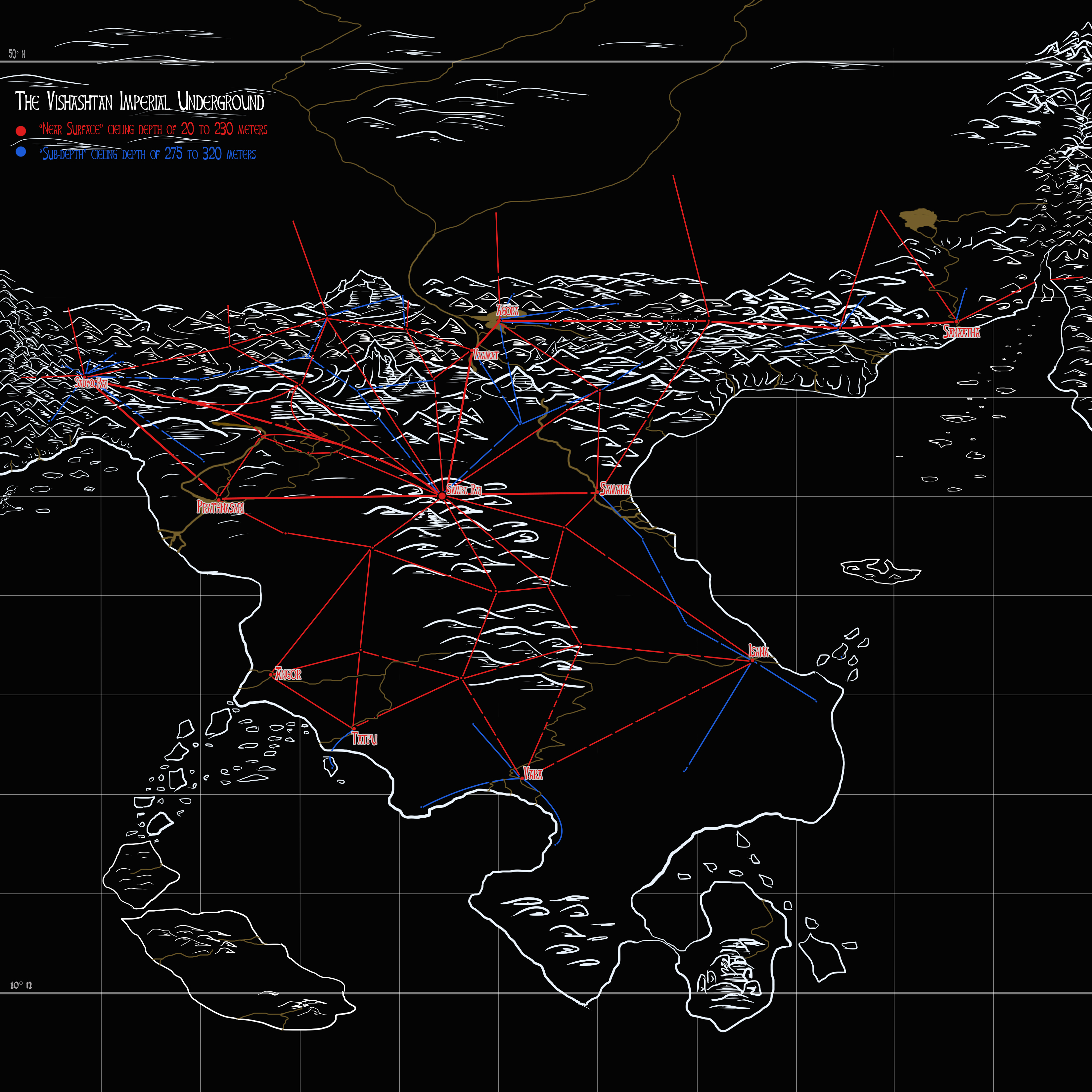
If you want to see in full screen and clicking the image here won't work.
Think of the marked tunnels as being about the width of five-lane highways at least and tower in height.
 1x Laugh
1x Laugh
